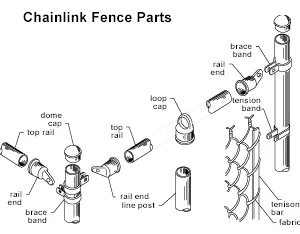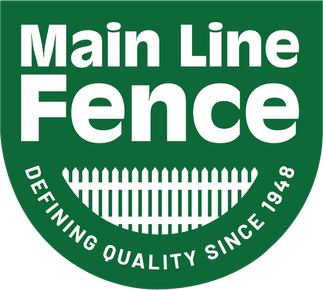- What is Chain Link Fabric?
Chain Link Fabric (also commonly known as wire or mesh) is formed by weaving a series of spirals together to make a diamond pattern that is available is a variety of sizes and gauges. The most common is a 2″ Pattern (for pool fences a diamond size of less than 2″ is required) with #9 gauge wire. The 2″ Pattern refers to the mesh size which is the distance between two parallel wires in the fabric. - What does the gauge of the wire refer to?
The individual spiral wires that are woven together to form the fabric are comprised of steel wire, gauge is the diameter of that wire. The higher the gauge number the smaller (thinner) the wire diameter. The most common gauges are 6 gauge (.192″), 9 gauge (.148″), 11 gauge (.120″) and 11-1/2 gauge (.113″). 9 Gauge is the most common wire sized used for both residential and commercial applications. 11 and 11-1/2 gauge are typically used for temporary fencing, while the 6 gauge is used in high security applications. - What does “selvage” refer to?
How the top and bottom (where the woven strands of wire are bent together) of the chain link fabric is finished is referred to as the selvage. The common selvage types are “Knuckle” and “Barbed” (or twisted). Knuckle is more round and thus safer, there are no sharp points to get caught on clothing or people. Barbed or twisted have sharp ends and are usually used in high security applications. - What type of coatings are available for chain link materials?
There are three major types of coatings available- Galvanized, Spectra and Permafused ll. Galvanizing is a zinc coating applied over bare steel, this provides one of the highest and most economical solutions for the prevention of rust and corrosion. All our galvanized components are hot dipped, which is a better bond that plating. Spectra and Permafused ll are commonly referred to as ‘Vinyl Coated.” Galvanized materials are coated with colored poly-coatings for additional protection and more attractive appearance. Spectra is most commonly used and is the least expensive vinyl coating. It is a polyester powder coating. Permafused ll is a more expensive and thicker polyolefin coating that used mostly for commercial applications. Both Vinyl Coatings are available in Green, Black and Brown colors. - What is the Framework?
Frame work is the tubular steel (or pipe) frame that chain link fabric is attached to. The framework is typically comprised of three major components- top rail, line posts and terminal posts. The chain link fence framework is also galvanized coated to provide protection against corrosion. We carry two common weights of pipe- SCH. 20 and SCH 40. Schedule (SCH) refers to the wall thickness of the tubular steel. SCH. 20 is most commonly used in residential applications. When referring to the size of the pipe, we measure the outside diameter. Much like the chain link wire, the framework is available with a vinyl coating. - What are fittings?
To assemble a chain link fence system, several types of fittings are required. There are specific fittings used for line posts, terminal posts and with gates. For most residential applications, lighter weight and more economical die cast steel or aluminum fittings are used. In commercial and industrial applications, fittings are typically made of cast iron or malleable steel. All our steel fittings are galvanized coated. The fittings secure the components of the fence, and in applications with gates they allow for movement and securing of the gate leafs. Please see our Chain Link Fence component guide below for more information. Vinyl coating fittings are also available for a complete vinyl coated fence system. - Do the posts need to be set in concrete footings?
No, it is not required that the posts be set in concrete footings. We typically recommend driving (or pounding) the posts in the ground to a minimum depth of 4′. We use a pneumatic post driver that literally hammers the post through the soil, for DIY installations you can use a handheld post driver (which we loan out). Driving posts into the ground allows for minimum disturbance of the naturally compacted soil, this helps prevent heaving and movement. Also, installation is faster and easier and has the least amount of impact on surrounding landscape. We do recommend that the gate and terminal posts sometimes be set in concrete footings, depending on the application and soil conditions- please ask your salesperson if this applies to your installation.

Chain Link Fence Components
There are many parts and pieces involved with a chain link fence system. Please refer to the photo below for the most common components. Also, you will find a wonderful installation instruction book developed by our main supplier, Master Halco. We stock all the components below if you are in need of everything for a new installation or just a few fittings for a repair.

